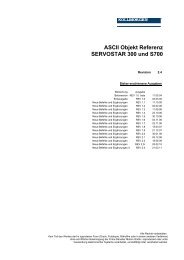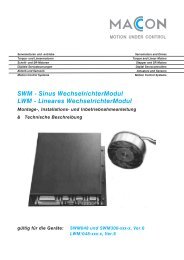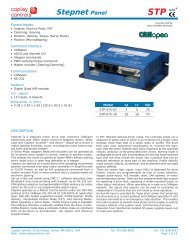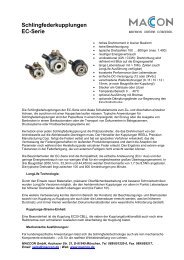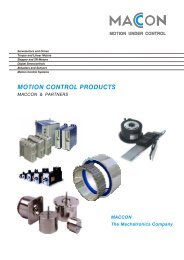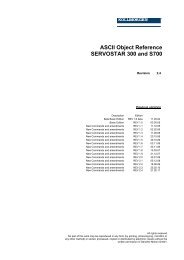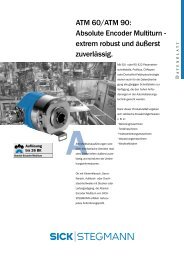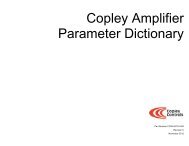CANopen Programmer's Manual - Maccon.de
CANopen Programmer's Manual - Maccon.de
CANopen Programmer's Manual - Maccon.de
Create successful ePaper yourself
Turn your PDF publications into a flip-book with our unique Google optimized e-Paper software.
<strong>CANopen</strong> Programmer’s <strong>Manual</strong> 9: Cyclic Synchronous Mo<strong>de</strong>s<br />
<strong>CANopen</strong> Standard IP Move Objects<br />
When the <strong>CANopen</strong> DSP-402 profile standard IP move objects are used, the interpolation<br />
submo<strong>de</strong> is chosen by setting a co<strong>de</strong> in Interpolation Submo<strong>de</strong> Select (in<strong>de</strong>x 0x60C0 p. 216) as<br />
<strong>de</strong>scribed here:<br />
IP Submo<strong>de</strong> Description<br />
0 Linear interpolation with a constant time.<br />
-1 Linear interpolation with variable time.<br />
-2 PVT interpolation.<br />
Linear Interpolation with a Constant Time<br />
In IP submo<strong>de</strong> 0, the trajectory target position of each segment is written to Interpolation Position<br />
Target (in<strong>de</strong>x 0x60C1, Sub-In<strong>de</strong>x 1, p. 217. Each time Interpolation Position Target is written to,<br />
the entire record is written to the amplifier’s internal buffers. (In mo<strong>de</strong> 0, Sub-In<strong>de</strong>x 2 and Sub-<br />
In<strong>de</strong>x 3 are ignored).<br />
The time interval is set in Interpolation Constant Time In<strong>de</strong>x (in<strong>de</strong>x 0x60C2, Sub-In<strong>de</strong>x 1, p. 218).<br />
Linear Interpolation with Variable Time<br />
In IP submo<strong>de</strong> -1, each trajectory segment can have a different time interval. The trajectory target<br />
position of each segment is written to Interpolation Position Target, which is Sub-In<strong>de</strong>x 1 of the<br />
Interpolation Data Record (in<strong>de</strong>x 0x60C1, p. 217). With each update to Interpolation Time (in<strong>de</strong>x<br />
0x60C1, Sub-In<strong>de</strong>x 2, p. 217), the entire record is written to the amplifier’s internal buffers.<br />
(In mo<strong>de</strong> -1, Sub-In<strong>de</strong>x 3 is ignored.)<br />
Cubic Polynomial (PVT) Interpolation<br />
In IP submo<strong>de</strong> -2, the trajectory target position of each segment is written to Interpolation Position<br />
Target (in<strong>de</strong>x 0x60C1, Sub-In<strong>de</strong>x 1, p. 217) and the segment time is written to Interpolation Time<br />
(in<strong>de</strong>x 0x60C1, Sub-In<strong>de</strong>x 2). When the segment velocity is written to Interpolation Velocity (in<strong>de</strong>x<br />
0x60C1, Sub-In<strong>de</strong>x 3, p. 217), the entire record is written to the amplifier’s internal buffers.<br />
Copley Controls Alternative Objects for IP Moves<br />
The Copley Controls alternative objects use bandwidth in a highly efficient manner. They also<br />
feature an integrity counter to i<strong>de</strong>ntify lost packets.<br />
Each profile segment is packed into a single 8-byte object in the object dictionary (IP move<br />
segment command, in<strong>de</strong>x 0x2010, p. 214). If a PDO is used to transmit the object, then a<br />
segment may be transmitted in a single CAN message.<br />
For a PVT example, see PVT Profile Moves Using the Copley Controls Alternative Objects, p. 212.<br />
Copley Controls 209




